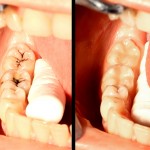
Composite restorations are regularly used to restore posterior teeth. Direct and indirect approaches are used. Small and medium sized cavities are usually restored with direct resin composite (DRC) with indirect resin composite (IRC) typically being used for more extensive cavities. However the DRC are increasingly being used for larger restorations.
The aim of this review was to assess the differences in clinical performance in direct and indirect resin composite restorations in permanent posterior teeth.
Methods
Searches were conducted in the Medline, Cochrane Library, Web of Science, Scopus, Latin American and Caribbean Health Sciences (LILACS), Brazilian Library of Dentistry (BBO), ClinicalTrials.gov and SIGLE databases.
Randomised controlled trials (RCTs) comparing the longevity of direct and indirect resin composite restorations in Class I or Class II cavities with or without cusp involvement and with at least two years of follow-up were considered. There were no restrictions regarding setting, language or year of publication. Two reviewers selected studies for inclusion, abstracted data and assessed risk of bias using four domains of the Cochrane tool (sequence generation, allocation concealment, incomplete outcome data and selective outcome reporting). A fixed effects meta-analysis was carried out.
Results
- 9 studies met the inclusion criteria with 6 contributing to the meta-analyses.
- 5 studies were considered to be at low risk of bias and one unclear.
- Pooled meta-analysis showed no statistically significant difference in clinical longevity for direct and indirect resin composite restorations, Relative risk (RR) = 1.494 (95%CI; 0.893-2.500, p = 0.126).
- Comparing molars and premolars restored with DRC and IRC at 3 years there was no significant difference, RR= 0.716 (95%CI; 0.177-2.888, p = 0.638).
Conclusions
The authors concluded: –
Based on the results of this systematic review and meta- analysis, there is evidence of no difference in terms of clinical longevity between direct and indirect resin composite restorations. This conclusion remains valid even when the type of restored tooth is taken into account. Therefore, it seems more reasonable to suggest that direct restorations should be given preference to indirect restorations in many situations, since the former require less effort and cost.
Comments
The authors have used a broad search strategy and restricted their inclusion criteria to RCTs. When assessing study quality the authors chose not to include the Cochrane risk of bias criteria, blinding of participants, personnel and outcome assessors. While given the nature of the comparison this is understandable this should be considered when assessing the findings, in particular the lack of outcome assessor blinding. The studies themselves are also relatively small, ranging for 8-80 patients and all have been conducted in a university setting.
Links
Primary paper
da Veiga AM, Cunha AC, Ferreira DM, da Silva Fidalgo TK, Chianca TK, Reis KR, Maia LC. Longevity of direct and indirect resin composite restorations in permanent posterior teeth: A systematic review and meta-analysis. J Dent. 2016 Aug 11. pii: S0300-5712(16)30160-9. doi: 10.1016/j.jdent.2016.08.003. [Epub ahead of print] Review. PubMed PMID: 27523636.
Other references
Original review Protocol on PROSPERO database
Dental Elf – 7th Sept 2016
Dental Elf – 13th Jul 2015
Amalgam has lower failure rate than composite in restorations
Dental Elf – 7th Apr 2014
Amalgam still an effective filling material for posterior teeth

[…] post Composite restorations: no difference in longevity with direct or indirect placement appeared […]
Composite restorations: no difference in longevity using direct or indirect placement https://t.co/9CiQiAMgzC
No difference in longevity of composite restorations with direct or indirect placement? https://t.co/9CiQiAMgzC
Wish we could get more robust studies-8-80 patients and all done in university setting. Also just a maximum of 3 years follow up isn’t too helpful . To make the conclusion the authors did to me is not supported by this study.
I would agree the conclusions are quite strong considering the limited available evidence and the fact they are in university setting. Larger well conducted studies of longer duration in typical practice environment would be ideal.
Longevity of direct and indirect resin composite restorations in permanent teeth https://t.co/9CiQiAMgzC
Little difference in longevity of composite restorations with direct or indirect placement https://t.co/9CiQiAMgzC
Don’t miss- Composite restorations: no difference in longevity with direct or indirect placement https://t.co/9CiQiAuFb2